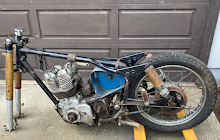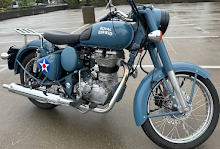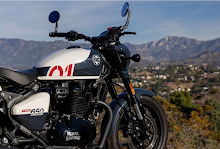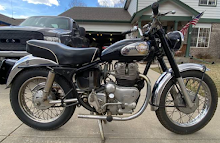 |
| Note that this 1922 Royal Enfield has bar-shaped footrest instead of full floor boards. The round pedal near footrest must be for rear brake! Coffee-grinder shifter is above tank. |
It wasn't necessary to fight the crowds to see the 1922 Royal Enfield Model 200 motorcycle on display at the Owls Head Transportation Museum in Maine last weekend.
There were more expensive and exotic motorcycles to be seen in the museum, along with priceless vintage automobiles and airplanes.
And — oh yeah — there was a car show going on outside the museum.
Also an air show, complete with flybys by a World War II P-51 Mustang.
 |
| Period ad touted Royal Enfield's two-speed transmission. |
I also couldn't get over or around the displays on either side of it to get a good photograph of it.
I didn't mind, since one of the neighboring exhibits was one of my favorite airplanes, the F.E.8 of World War I. This dandy little British fighter plane put the pilot and his machine gun in front of the motor, so that it could not shoot off its own propeller.
By the time the F.E.8 reached combat the Germans had worked out how to synchronize their machine guns to safely fire through whirling propellers. The F.E.8 was obsolete.
 |
| F.E.8 was shown nose down, displaying the cockpit. |
The museum's F.E.8 is, of course, a replica, built from factory plans. Disappointed it's not original?
"How would you like to fly in an airplane with 100-year-old wood in it?" noted one pilot we met at the museum.
 |
| The replica F.E.8 as it appeared in flight. |
 |
| Sopwith Pup was light as a kite, but gun sight shows it meant business. |
After the Pup took off a gusting crosswind came up and the crowd wondered if it might flip the kite-like little airplane when it tried to land. (It landed safely, out of sight of the crowd.)
 |
| 1919 Sopwith motorcycle was surprisingly sophisticated. |
Sophistication made it expensive and production ended in 1921, two years before BMW introduced its remarkably similar and far more successful motorcycle.
 |
| 1913 Excelsior V-twin displays perfect patina. |
 |
| Low and loud: World War II vintage Navy SNJ trainer buzzes the airfield. |
My wife Bonnie got some short videos of the planes. Take a peek:



























No comments:
Post a Comment